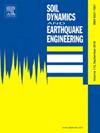Shaking table test and numerical study of high-speed railway simply supported girder bridge with combined damping system subjected to strong earthquakes
IF 4.2
2区 工程技术
Q1 ENGINEERING, GEOLOGICAL
引用次数: 0
Abstract
To reduce the damage of high-speed railway bridges in strong earthquake areas, this paper innovatively proposed a composite damping system consisting of “friction pendulum bearing (FPB) + metal dampers + limited-plates'. A scaled shaking table test and numerical simulations of a high-speed railway simply supported girder bridge under various earthquake intensities of 9° (frequently occurred earthquake (FOE), fortification earthquake (FE), and rarely occurred earthquake (ROE)) were performed to verify the feasibility and effectiveness of the composite damping system. The test results showed that in the case of FOE, the scaled bridge was intact; in the case of FE, the FPBs started sliding after the shear pins being cut off, and the metal dampers deformed accordingly, causing microcracks in the bottom of piers; in the case of ROE, the beam collide with the limited-plates, limiting the relative displacement of the pier and girder and extending the cracks on the base of the piers without concrete peeling. Then, a finite element model equipped with the composite damping system was calibrated by the test results. Furthermore, from the perspectives of seismic reduction rate and energy dissipation, it was further clarified that the combined damping system exhibited graded energy dissipation, seismic isolation, and displacement limitation functions, demonstrating superior seismic isolation performance. The research can offer a novel approach for the isolation technology of high-speed railway bridges in high intensity earthquake areas.
带组合阻尼系统的高速铁路简支梁桥在强震中的振动台试验和数值研究
为降低强震区高速铁路桥梁的损伤,创新性地提出了“摩擦摆支座+金属阻尼器+限位板”的复合阻尼系统。以某高速铁路简支梁桥为研究对象,进行了9°不同烈度地震(多发地震(FOE)、设防地震(FE)和罕见地震(ROE))下的比例振动台试验和数值模拟,验证了复合阻尼系统的可行性和有效性。试验结果表明,在FOE情况下,比例桥梁是完整的;在有限元情况下,剪切销被切断后,fpb开始滑动,金属阻尼器随之变形,导致桥墩底部出现微裂纹;ROE情况下,梁与限位板发生碰撞,限制了墩与梁的相对位移,扩大了桥墩底部的裂缝,且无混凝土剥落。然后,根据试验结果对复合阻尼系统的有限元模型进行了标定。从减震率和耗能两方面进一步阐明了组合阻尼体系具有分级耗能、隔震和位移限制功能,具有较好的隔震性能。该研究为高烈度地震区高速铁路桥梁隔震技术提供了新的思路。
本文章由计算机程序翻译,如有差异,请以英文原文为准。
求助全文
约1分钟内获得全文
求助全文
来源期刊

Soil Dynamics and Earthquake Engineering
工程技术-地球科学综合
CiteScore
7.50
自引率
15.00%
发文量
446
审稿时长
8 months
期刊介绍:
The journal aims to encourage and enhance the role of mechanics and other disciplines as they relate to earthquake engineering by providing opportunities for the publication of the work of applied mathematicians, engineers and other applied scientists involved in solving problems closely related to the field of earthquake engineering and geotechnical earthquake engineering.
Emphasis is placed on new concepts and techniques, but case histories will also be published if they enhance the presentation and understanding of new technical concepts.
 求助内容:
求助内容: 应助结果提醒方式:
应助结果提醒方式:


